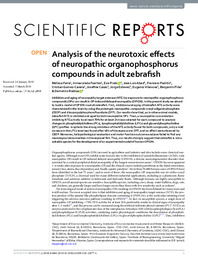Por favor, use este identificador para citar o enlazar este ítem:
https://hdl.handle.net/11000/30725Registro completo de metadatos
| Campo DC | Valor | Lengua/Idioma |
|---|---|---|
| dc.contributor.author | Faria, Melissa | - |
| dc.contributor.author | Fuertes, Inmaculada | - |
| dc.contributor.author | Prats, Eva | - |
| dc.contributor.author | Abad, José-Luis | - |
| dc.contributor.author | Padrós, Francesc Xavier | - |
| dc.contributor.author | Gómez-Canela, Cristian | - |
| dc.contributor.author | CASAS-SOLIS, JOSEFINA | - |
| dc.contributor.author | Jorge, Estévez | - |
| dc.contributor.author | Vilanova, Eugenio | - |
| dc.contributor.author | Piña, Benjamín | - |
| dc.contributor.author | Raldúa, Demetrio | - |
| dc.contributor.other | Departamentos de la UMH::Biología Aplicada | es_ES |
| dc.date.accessioned | 2024-01-26T10:35:37Z | - |
| dc.date.available | 2024-01-26T10:35:37Z | - |
| dc.date.created | 2018-03-05 | - |
| dc.identifier.citation | Scientific Reports, (2018) 8:4844 | es_ES |
| dc.identifier.issn | 2045-2322 | - |
| dc.identifier.uri | https://hdl.handle.net/11000/30725 | - |
| dc.description.abstract | Inhibition and aging of neuropathy target esterase (NTE) by exposure to neuropathic organophosphorus compounds (OPs) can result in OP-induced delayed neuropathy (OPIDN). In the present study we aimed to build a model of OPIDN in adult zebrafish. First, inhibition and aging of zebrafish NTE activity were characterized in the brain by using the prototypic neuropathic compounds cresyl saligenin phosphate (CBDP) and diisopropylphosphorofluoridate (DFP). Our results show that, as in other animal models, zebrafish NTE is inhibited and aged by both neuropathic OPs. Then, a neuropathic concentration inhibiting NTE activity by at least 70% for at least 24 h was selected for each compound to analyze changes in phosphatidylcholines (PCs), lysophosphatidylcholines (LPCs) and glycerolphosphocholine (GPC) profiles. In spite to the strong inhibition of the NTE activity found for both compounds, only a mild increase in the LPCs level was found after 48 h of the exposure to DFP, and no effect were observed by CBDP. Moreover, histopathological evaluation and motor function outcome analyses failed to find any neurological abnormalities in the exposed fish. Thus, our results strongly suggest that zebrafish is not a suitable species for the development of an experimental model of human OPIDN. | es_ES |
| dc.format | application/pdf | es_ES |
| dc.format.extent | 14 | es_ES |
| dc.language.iso | eng | es_ES |
| dc.publisher | Nature Research | es_ES |
| dc.rights | info:eu-repo/semantics/openAccess | es_ES |
| dc.rights | Attribution-NonCommercial-NoDerivatives 4.0 Internacional | * |
| dc.rights.uri | http://creativecommons.org/licenses/by-nc-nd/4.0/ | * |
| dc.subject.classification | Toxicología | es_ES |
| dc.subject.other | CDU::5 - Ciencias puras y naturales::57 - Biología | es_ES |
| dc.title | Analysis of the neurotoxic effects of neuropathic organophosphorus compounds in adult zebrafish | es_ES |
| dc.type | info:eu-repo/semantics/article | es_ES |
| dc.relation.publisherversion | https://doi.org/10.1038/s41598-018-22977-4 | es_ES |

Ver/Abrir:
s41598-018-22977-4.pdf
3,04 MB
Adobe PDF
Compartir:
 La licencia se describe como: Atribución-NonComercial-NoDerivada 4.0 Internacional.
La licencia se describe como: Atribución-NonComercial-NoDerivada 4.0 Internacional.
.png)